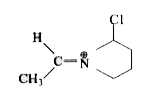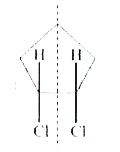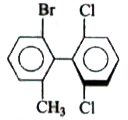The compound that is chiral
3-Methyl-3-hexane
1-Chloro-4-methylcyclohexane
2-Phenylpentane
1,3-Diisopropylbenzene
The correct Answer is:C
To determine which compounds are chiral, we need to identify the presence of chiral carbon atoms in each compound. A chiral carbon atom is one that has four different groups attached to it. Let's analyze the given compounds step by step.
Step 1: Analyze 3-Methylhexane
1. Structure: The structure of 3-methylhexane is CH3-CH2-CH(CH3)-CH2-CH2-CH3.
2. Identify Carbon Atoms: Check each carbon atom in the chain.
3. Chirality Check:
- Carbon 1 (CH3): Attached to three hydrogens (not chiral).
- Carbon 2 (CH2): Attached to two hydrogens (not chiral).
- Carbon 3 (CH): Attached to one hydrogen, one methyl (CH3), one ethyl (CH2-CH3), and one propyl (CH2-CH2-CH3) group (this is chiral).
- Carbon 4 (CH2): Attached to two hydrogens (not chiral).
- Carbon 5 (CH2): Attached to two hydrogens (not chiral).
- Carbon 6 (CH3): Attached to three hydrogens (not chiral).
4. Conclusion: 3-Methylhexane has one chiral carbon atom (Carbon 3), so it is a chiral compound.
Step 2: Analyze 1-Chloro-4-methylcyclohexane
1. Structure: The structure is cyclohexane with a chlorine and a methyl group.
2. Identify Carbon Atoms: Check each carbon atom in the cyclohexane ring.
3. Chirality Check:
- All carbon atoms in the ring have at least two hydrogens attached (not chiral).
- The carbon with chlorine and methyl has two identical groups (hydrogens) attached (not chiral).
4. Conclusion: There are no chiral carbon atoms in 1-chloro-4-methylcyclohexane, so it is not a chiral compound.
Step 3: Analyze 1-Phenyl-2-methylpropane
1. Structure: The structure is CH3-CH(CH3)-CH2-phenyl.
2. Identify Carbon Atoms: Check each carbon atom.
3. Chirality Check:
- Carbon 1 (CH3): Attached to three hydrogens (not chiral).
- Carbon 2 (CH): Attached to one hydrogen, one methyl (CH3), one phenyl, and one propyl group (this is chiral).
- Carbon 3 (CH2): Attached to two hydrogens (not chiral).
4. Conclusion: 1-Phenyl-2-methylpropane has one chiral carbon atom (Carbon 2), so it is a chiral compound.
Step 4: Analyze 1,3-Diisopropylbenzene
1. Structure: The structure is benzene with two isopropyl groups.
2. Identify Carbon Atoms: Check each carbon atom in the benzene ring and the isopropyl groups.
3. Chirality Check:
- All carbon atoms in the benzene ring are attached to at least two hydrogens (not chiral).
- The carbon atoms in the isopropyl groups have two identical groups (methyls) attached (not chiral).
4. Conclusion: There are no chiral carbon atoms in 1,3-diisopropylbenzene, so it is not a chiral compound.
Final Conclusion
The chiral compounds identified are:
- 3-Methylhexane
- 1-Phenyl-2-methylpropane
1. Structure: The structure of 3-methylhexane is CH3-CH2-CH(CH3)-CH2-CH2-CH3.
2. Identify Carbon Atoms: Check each carbon atom in the chain.
3. Chirality Check:
- Carbon 1 (CH3): Attached to three hydrogens (not chiral).
- Carbon 2 (CH2): Attached to two hydrogens (not chiral).
- Carbon 3 (CH): Attached to one hydrogen, one methyl (CH3), one ethyl (CH2-CH3), and one propyl (CH2-CH2-CH3) group (this is chiral).
- Carbon 4 (CH2): Attached to two hydrogens (not chiral).
- Carbon 5 (CH2): Attached to two hydrogens (not chiral).
- Carbon 6 (CH3): Attached to three hydrogens (not chiral).
4. Conclusion: 3-Methylhexane has one chiral carbon atom (Carbon 3), so it is a chiral compound.
1. Structure: The structure is cyclohexane with a chlorine and a methyl group.
2. Identify Carbon Atoms: Check each carbon atom in the cyclohexane ring.
3. Chirality Check:
- All carbon atoms in the ring have at least two hydrogens attached (not chiral).
- The carbon with chlorine and methyl has two identical groups (hydrogens) attached (not chiral).
4. Conclusion: There are no chiral carbon atoms in 1-chloro-4-methylcyclohexane, so it is not a chiral compound.
1. Structure: The structure is CH3-CH(CH3)-CH2-phenyl.
2. Identify Carbon Atoms: Check each carbon atom.
3. Chirality Check:
- Carbon 1 (CH3): Attached to three hydrogens (not chiral).
- Carbon 2 (CH): Attached to one hydrogen, one methyl (CH3), one phenyl, and one propyl group (this is chiral).
- Carbon 3 (CH2): Attached to two hydrogens (not chiral).
4. Conclusion: 1-Phenyl-2-methylpropane has one chiral carbon atom (Carbon 2), so it is a chiral compound.
1. Structure: The structure is benzene with two isopropyl groups.
2. Identify Carbon Atoms: Check each carbon atom in the benzene ring and the isopropyl groups.
3. Chirality Check:
- All carbon atoms in the benzene ring are attached to at least two hydrogens (not chiral).
- The carbon atoms in the isopropyl groups have two identical groups (methyls) attached (not chiral).
4. Conclusion: There are no chiral carbon atoms in 1,3-diisopropylbenzene, so it is not a chiral compound.
The chiral compounds identified are:
- 3-Methylhexane
- 1-Phenyl-2-methylpropane
Topper's Solved these Questions
- STEREOISOMERISMBook:RESONANCE ENGLISHChapter:STEREOISOMERISMExercise:EXERCISE (PART III : PRACTICE TEST-2 (IIT-JEE (ADVANCED PATTERN))
Explore 23 Videos
- STEREOISOMERISMBook:RESONANCE ENGLISHChapter:STEREOISOMERISMExercise:EXERCISE (ADDITIONAL PROBLEMS FOR SELF PRACTICE (APSP)) PART 1
Explore 30 Videos
- SOLUTIONSBook:RESONANCE ENGLISHChapter:SOLUTIONSExercise:Advabced Level Problems (PART-2)
Explore 35 Videos
- STRUCTURAL IDENTIFICATIONBook:RESONANCE ENGLISHChapter:STRUCTURAL IDENTIFICATIONExercise:Advanced level Problems (Part-III)
Explore 12 Videos
Similar Questions
Knowledge Check
Which of the following compounds is chiral?
A B
B C
C D
D
Which of the following compounds is chiral?
A B
B C
C DAll of these
DAll of theseA line which bisects a compound in two equal parts and both parts humou parto que ainda sono go appear to be the mirror image of each other, such kind of symmetry is known as plane of symmetry.
Any molecule that has a internal mirror plane of symmetry cannot be iis TV chiral, even though it may contain asymmetric carboni atoms.

Which of the following compounds is not chiral?A B
B C
C D
D
Which of the following compounds is not chiral?
View SolutionWhich of the following compounds is not chiral ?
View SolutionWhich of the following compounds is not chiral?
View SolutionA compound is chiral even if
View SolutionThe formation of an optically active compound from a chiral molecule is called:
View Solution
